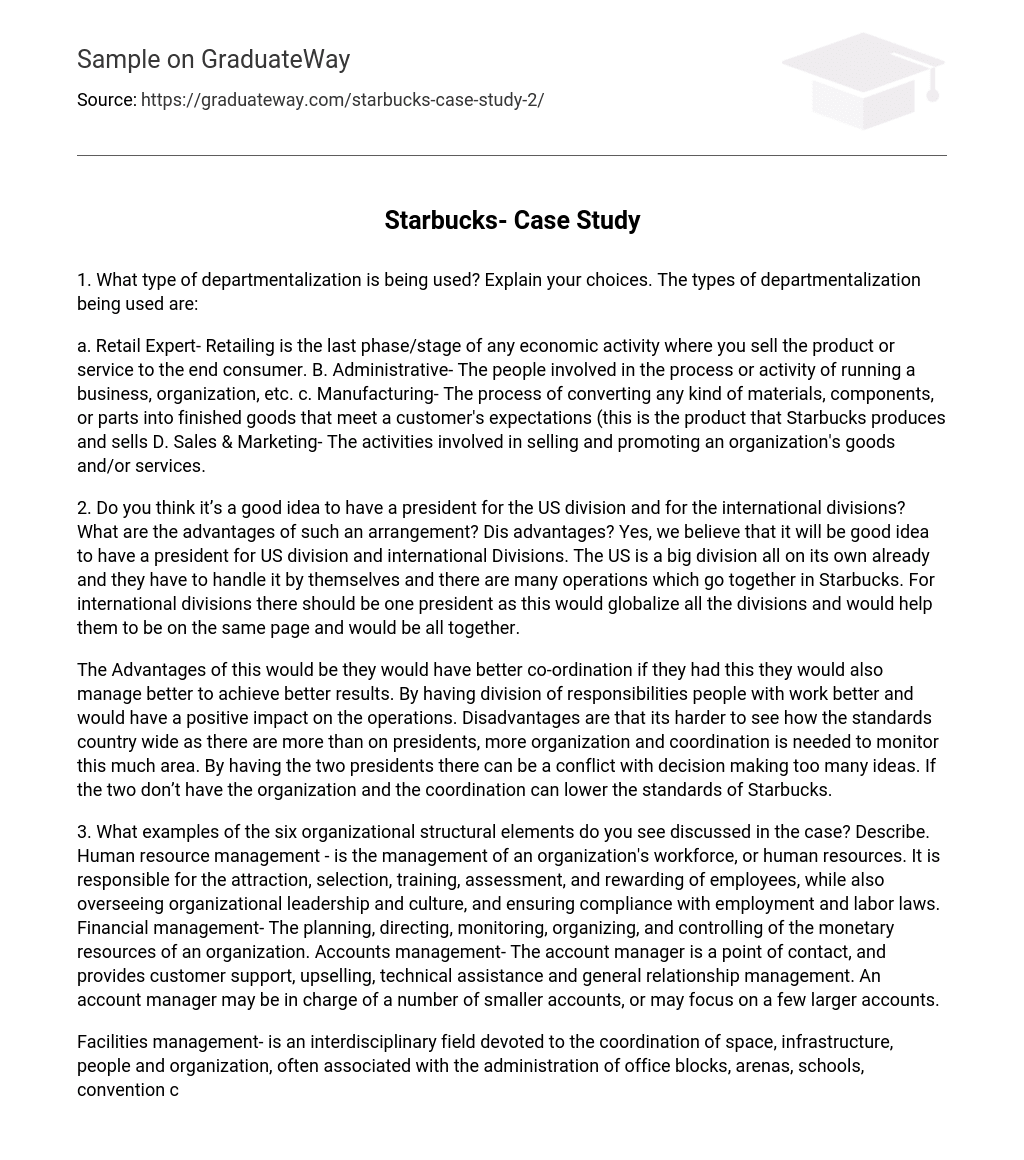1. What type of departmentalization is being used? Explain your choices. The types of departmentalization being used are:
a. Retail Expert- Retailing is the last phase/stage of any economic activity where you sell the product or service to the end consumer. B. Administrative- The people involved in the process or activity of running a business, organization, etc. c. Manufacturing- The process of converting any kind of materials, components, or parts into finished goods that meet a customer’s expectations (this is the product that Starbucks produces and sells D. Sales & Marketing- The activities involved in selling and promoting an organization’s goods and/or services.
2. Do you think it’s a good idea to have a president for the US division and for the international divisions? What are the advantages of such an arrangement? Dis advantages? Yes, we believe that it will be good idea to have a president for US division and international Divisions. The US is a big division all on its own already and they have to handle it by themselves and there are many operations which go together in Starbucks. For international divisions there should be one president as this would globalize all the divisions and would help them to be on the same page and would be all together.
The Advantages of this would be they would have better co-ordination if they had this they would also manage better to achieve better results. By having division of responsibilities people with work better and would have a positive impact on the operations. Disadvantages are that its harder to see how the standards country wide as there are more than on presidents, more organization and coordination is needed to monitor this much area. By having the two presidents there can be a conflict with decision making too many ideas. If the two don’t have the organization and the coordination can lower the standards of Starbucks.
3. What examples of the six organizational structural elements do you see discussed in the case? Describe. Human resource management – is the management of an organization’s workforce, or human resources. It is responsible for the attraction, selection, training, assessment, and rewarding of employees, while also overseeing organizational leadership and culture, and ensuring compliance with employment and labor laws. Financial management- The planning, directing, monitoring, organizing, and controlling of the monetary resources of an organization. Accounts management- The account manager is a point of contact, and provides customer support, upselling, technical assistance and general relationship management. An account manager may be in charge of a number of smaller accounts, or may focus on a few larger accounts.
Facilities management- is an interdisciplinary field devoted to the coordination of space, infrastructure, people and organization, often associated with the administration of office blocks, arenas, schools, convention centers, shopping complexes, hospitals, hotels, etc. However, FM facilitates on a much wider range of activities than just business services and these are referred to as non-core functions Sales management- The sales manager is the person responsible for leading and guiding a team of salespeople. A sales manager’s tasks often include assigning sales territories, setting quotas, mentoring the members of her sales team, assigning sales training, building a sales plan, and hiring and firing salespeople Supply sales management- The main goals within supply management are to control costs, efficiently allocate resources and gather information to be used in strategic business decisions.
4. Considering the expense associated with having more managers, what are some reasons why you think Starbucks decided to decrease the number of stores each district manager was responsible for, thus increasing the number of managers needed? Other than the expense, can you think of any disadvantages to this decision? Starbucks decided to decrease the number of stores as it would make work more manageable





